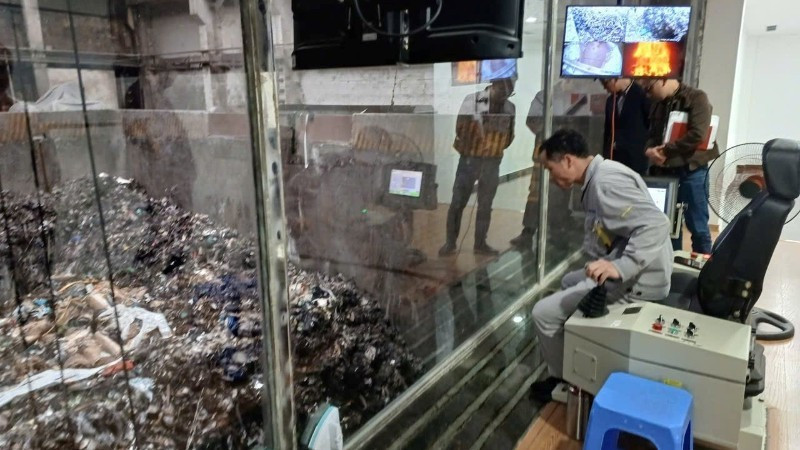Reducing environmental pollution through circular economy
Many economic sectors in Viet Nam are presented with significant opportunities to transition to a circular economy model. Making use of by-products and recycling waste not only reduces pollution but also opens pathways to sustainable development and increases economic value.

The modern economy
The negative impacts of climate change, the need to improve the quality of sustainable growth, environmental protection requirements, and particularly the depletion of natural resources have been driving many countries towards a circular economy.
Operating a circular economy reduces negative environmental impacts. Resources are used and reused multiple times throughout their lifecycles, coupled with the application of advanced, environmentally friendly technology, forming interconnected chains that can maximise the utilisation of all waste types and by-products in the production process.
Globally, a range of circular economy models have proved successful, including sharing platforms (Grab, Airbnb), recycling ecosystems (Ellen MacArthur Foundation, Loop), closed-loop lifecycles (Bosch, Philips), industrial ecology (Kalundborg), and systems for recycling, recovery and reuse for end-of-life vehicles in developed economies like Japan, the UK, and the European Union (EU).
According to Associate Professor Nguyen Dinh Tho, Deputy Director of the Institute of Strategy and Policy on Agriculture and Environment, most economic sectors in Viet Nam have the potential to implement circular economy practices: recovering heat and using recycled materials in industry; recovering and reusing by-products and waste in agriculture; producing green materials; expanding renewable energy; greening transport; and scaling up waste recycling.
Recognising the importance of transitioning to a circular economy, Viet Nam has completed a legal foundation for implementation in documents, including the national action plan on circular economy to 2035, regulations on environmental criteria and confirmation of investment projects under the green classification list, and the Prime Minister’s directive on urgent solutions to prevent environmental pollution.
Furthermore, Article 142 of the 2020 Environmental Protection Law clearly sets out the responsibilities of all parties in implementing the circular economy, from state agencies to production and commercial establishments.
However, the transition process to a circular economy is facing many challenges such as entrenched consumers’ habits, limits in science, technology, infrastructure, capital and human resources, and inconsistent legal frameworks.
Positive environmental impact
Currently, many pollution-intensive sectors need to transform, notably the seafood industry. According to Le Hang, Deputy Secretary-General of the Viet Nam Association of Seafood Exporters and Producers, with annual export revenue of up to 11 billion USD, the seafood industry plays an important role in socio-economic development, creating livelihoods for millions of workers. However, it also faces challenges from climate change, resource depletion, outdated production models, weak integration along the value chain, and stringent quality requirements.
The sector’s transition to a circular economy model not only opens opportunities to exploit new resources from by-products and waste in production and processing but also reduces negative impacts and contributes to environmental regeneration.
Notable examples include the biological and technological solution known as the recirculating aquaculture system (RAS) being promoted by the German development agency GIZ, Aqua Mina chemical-free water treatment technology, Thang Long circular filtration system, Uni-President’s automatic shrimp siphoning system, application of microbial and biological technology in bacterial control and feed management, enzyme technology, and plastic waste management.
Alongside economic gains, seafood industry establishments applying circular practices have reduced pollutants by more than 40%. This is an encouraging signal for economic sectors with close environmental links such as seafood and livestock farming.
For sectors using raw materials from agricultural products, the circular economy is also making a substantial difference.
“Even a small enterprise, when applying the circular economy model, shows effectiveness. Beyond the economic benefits, our model reduces waste and makes use of by-products after production,” shared Phan Thi Nhuan, Director of My Duc Silk Company, which specialises in silk products from mulberry and lotus.
The company generates around 500 tonnes of production waste each year. By processing this waste into products such as fertiliser and biological products, it has generated 500 million VND in revenue, excluding savings in waste treatment costs.
In many countries, the circular economy is being shaped coherently from policy through to practice. Japan, for example, demonstrates broad participation from government to citizens. Companies such as Toyota, Uniqlo and Honda prioritise easily recyclable and reusable materials, alongside measures to reduce emissions across the entire production chain. Farms apply closed-loop waste and wastewater treatment cycles.
Japan’s success stems from a clear, synchronised legal framework, combined with public and business awareness of environmental protection. Supportive policies for finance, taxation and technology transfer further encourage enterprise adoption.
From successful models in developed economies to pilot projects in Viet Nam, the circular economy is emerging as an inevitable trend in the modern economy. In addition to superior economic efficiency, the environmental benefits alone demonstrate its potential within the national economic structure.
However, for the circular economy to be effective, synchronised solutions need to be implemented, including completing legal frameworks and policies; capital mobilisation mechanism and tax; investment in infrastructure and science-technology; resource mobilisation; building financial markets; forming green consumption habits; and building closed supply chains.
Additionally, a long-term strategy is needed to improve human resource quality and to raise awareness of environmental protection among the public, especially the younger generation.








